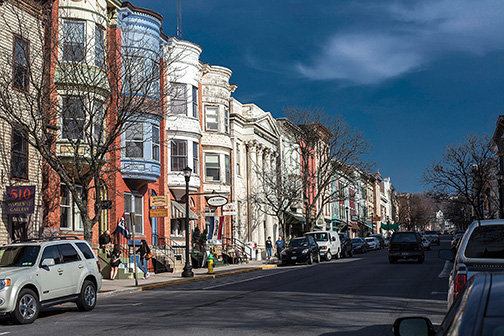
Hudson streetscapes; photographs by Dan Region.
In September 1609, in search of a northwest passage to Asia, Henry Hudson and his crew sailed their ship the Half Moon up a course of water that the locals then called Mohicanituk (“River That Flows Both Ways”). Hudson anchored for a time near a piece of land on which a city would arise that, like the river, bears his name. When it was chartered in 1785, the city of Hudson, New York, was a whaling town. Vessels sailed the more than one hundred nautical miles from Hudson to the New York harbor on their way to the fertile whaling grounds of the Atlantic and Pacific. When kerosene and other fuels gained market share in the mid-1800s, the town transitioned to manufacturing, supporting textile factories, brickyards, and operations such as the Allen Paper Car Wheel Works, which made parts for George Pullman’s luxurious passenger trains.

Hudson streetscapes; photographs by Dan Region.
In the early years of the twentieth century, the town’s biggest growth industry was vice. Hudson was renowned for its brothels—even in Europe—and became a haven for bootleggers during Prohibition. The honky-tonk era lasted until 1950, when the bordellos were shuttered in a spectacular state police raid. In subsequent decades, as factory after factory closed, Hudson was left high and dry. But in the 1980s and ‘90s, a trickle and then a steady flow of New Yorkers, weary of the city, began migrating north, establishing country homes in the area and pied-à-terres in town. They were accompanied up the river by antiques and design dealers in search of bigger stores and cheaper rent. Today Hudson is an antiquarian’s fantasy land, with scores of shops on and just off Warren Street, the spine of the town.

Hudson streetscapes; photographs by Dan Region.
While having a knack for reinvention, the people of Hudson also know how to preserve their heritage, as evidenced by the town’s diverse architecture. Victorian, Federal, Greek revival, Arts and Crafts, Gothic revival, Italianate and Queen Anne style buildings can be found along its streets, nestled among mature, spreading oaks. One of the most interesting structures in town is the performing arts center Hudson Hall, which dates from 1855 and is New York state’s oldest surviving theater—though it has served many purposes. Built as city hall, it has at one point or another housed a post office, a police station, a library, and a bank. Finding new uses for old buildings has become a habit in Hudson. The rock star bass player Melissa auf der Mauer transformed an 1880 foundry into the arts and events space Basilica Hudson; the e-commerce website Etsy has an office annex housed in a onetime lumber mill.

Hudson streetscapes; photographs by Dan Region.
The population of this riparian paradise has thinned a bit since its eleven-thousand-soul heyday. It ain’t the big city, and it’s no longer a den of iniquity, but that doesn’t mean Frank Serpico, who lives in the area, isn’t keeping a watchful eye. Don’t plan on identifying him, though—he carries himself as if he were still on the force, working undercover.

